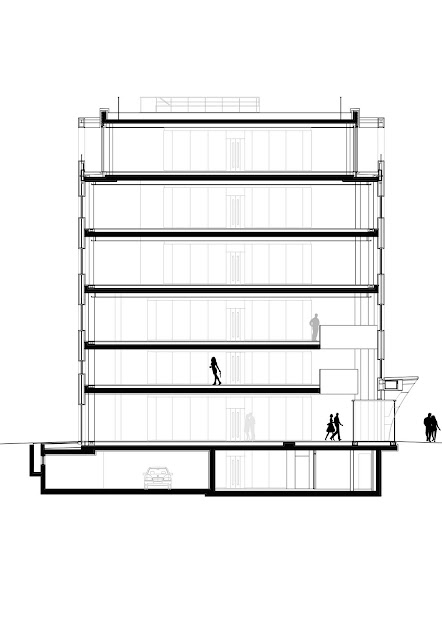Berlin, Germany
Gnädinger Architekten
Post By:Kitticoon Poopong
 |
| Photo © Courtesy of Gnädinger Architekten |
The
Otto Bock Science Center Medical Technology by German architectural firm
Gnädinger Architekten was started from the idea of human
muscle fibers, a metaphor for the simulation of complex
biological processes and structures. Gnädinger created an amorphous, abstract façade, which wraps dynamically around the six-storey,
reinforced concrete frame, encompassing around 1,000 square meters of floor space.
 |
| Photo © Courtesy of Gnädinger Architekten |
 |
| Photo © Courtesy of Gnädinger Architekten |
"The architectural design was intended to bring high-tech and nature together in a harmonious manner. The organically-formed, white exterior buckled bands encircle the rounded body of the building, based on the model of human muscle fibers, a metaphor for the simulation of complex biological processes and structures."
Gnädinger Architekten
 |
| Photo © Courtesy of Gnädinger Architekten |
 |
| Photo © Courtesy of Gnädinger Architekten |
Description by Gnädinger Architekten
A new building presents itself in the center of the New Berlin – the Science Center Medical Technology at
Potsdamer Platz.
The new building is the representative office in the capital city for the medical technology company
Otto Bock HealthCare GmbH. The team of
Gnädinger Architects, together with the media designers Art+Com developed this unique public stage for the topic of movement, which is the first of it’s kind in the world. An exhibition invites visitors to “discover what moves us”. Starting from the idea of human muscle fibers, the Berlin architectural firm Gnädinger created an amorphous, abstract façade, which wraps dynamically around the six-storey, reinforced concrete frame, encompassing around 1,000 square meters of floor space.
 |
| Photo © Courtesy of Gnädinger Architekten |
 |
| Photo © Courtesy of Gnädinger Architekten |
The architectural design was intended to bring high-tech and nature together in a harmonious manner. The organically-formed, white exterior buckled bands encircle the rounded body of the building, based on the model of human muscle fibers, a metaphor for the simulation of complex biological processes and structures.
 |
| Photo © Courtesy of Gnädinger Architekten |
 |
| Photo © Courtesy of Gnädinger Architekten |
The outer shell, an expressive aluminum and glass façade, is unusual for the city of Berlin, and provides a kind of acupuncture of new architecture amongst Berlin’s traditional stone buildings and glassy modernism. In the immediate vicinity of buildings by architects ranging from Richard Rogers, Renzo Piano, Hans Kollhoff and Helmut Jahn, this compact structure demonstrates a confident independence. The Science Center Medical Technology responds to the context of the city’s stone buildings and their serially repetitive stylistic devices with a new sensual, individualistic quality. With its complex, flowing forms based on freeform curves (splines), a new vibrancy is created, which goes beyond the already well-known standard of the tediously serial. The building therefore takes up this conceptual game in order to rediscover sensuality in the contemporary implementation of ornament in architecture.
 |
| Photo © Courtesy of Gnädinger Architekten |
 |
| Photo © Courtesy of Gnädinger Architekten |
 |
| Photo © Courtesy of Gnädinger Architekten |
Behind the extravagant exterior with its convex and concave, tapered lines, three levels serve as exhibition space on over 500 square meters. The fourth level is for training and conference rooms and the top floor serves as a dialogue platform for interdisciplinary communication between doctors, patients, therapists, orthopedic technicians and manufacturers. Inside, the functional surfaces surround a central access and technical core. The zoning of the plan with a windmill-like access system allows the planning of different room sizes. Here, the architects arrange the floor space on the periphery and along the glass cladding, so that even behind the dynamic facade, daylight is guaranteed throughout the room, giving the building high quality as a residence and workplace.
 |
| Photo © Courtesy of Gnädinger Architekten |
 |
| Photo © Courtesy of Gnädinger Architekten |
 |
| Photo © Courtesy of Gnädinger Architekten |
 |
| Photo © Courtesy of Gnädinger Architekten |
The interior is consistently minimalist. The surfaces are white, with silver-gray stone or carpet on the floors. Even the furniture and the exhibits are predominantly white. At the core, in contrast, are colored glass panels with integrated TV monitors to provide information. Dark, wooden panels create atmospheric accents in the elevator and a few select places. Illumination is provided by means of so-called “light cells”, which are freely arranged, round light fields of various sizes and heights. The central, three-storey, steel staircase in the exhibition area was designed as a giant, sculptural light object. The translucent foil on the underside is fully backlit.
 |
| Photo © Courtesy of Gnädinger Architekten |
 |
| Photo © Courtesy of Gnädinger Architekten |
 |
| Photo © Courtesy of Gnädinger Architekten |
 |
| Photo © Courtesy of Gnädinger Architekten |
 |
| Photo © Courtesy of Gnädinger Architekten |
 |
| Photo © Courtesy of Gnädinger Architekten |
 |
| site plan--drawing Courtesy of Gnädinger Architekten |
 |
| ground floor plan--drawing Courtesy of Gnädinger Architekten |
 |
| section--drawing Courtesy of Gnädinger Architekten |
The people
Architects: Gnädinger Architekten
Location: Berlin, Germany
Photographs: Courtesy of Gnädinger Architekten


























